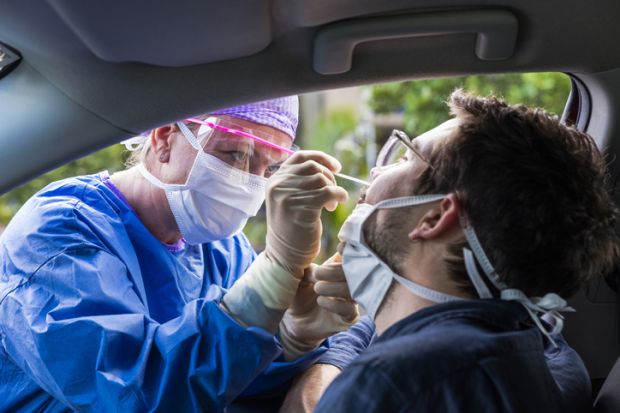Most US universities are not consistently testing their students for coronavirus, helping to spread the disease through their communities, amid a lack of government guidance and funding, expert analyses have concluded.
After a summer in which the Trump administration recommended colleges only test students with symptoms, surveys suggest that two-thirds of US institutions have managed little if anything more ambitious than that.
At the same time, US colleges have accounted for some 2,000 to 3,000 new infections daily this autumn, helping push the world’s most infected nation back upward in its average case counts after a summertime decline.
Anticipating such a situation, dozens of US colleges and universities teamed up this summer to create their own Covid testing coalitions. But the government has done little to help them reduce costs, creating a divide between those institutions with the necessary finances, expertise and connections to test frequently, and the majority that do not.
“Not all can afford to do this,” said Davidson Hamer, a professor of global health and medicine at Boston University, which built its own testing lab and procured its supplies. “And that’s a barrier.”
Part of the problem goes back to the US Centers for Disease Control and Prevention, which has been tailoring its medical guidance to reflect Trump administration scepticism toward the danger posed by Covid. The CDC did not suggest testing students as they returned to campus or routinely testing them during the autumn term.
Experts at the College Crisis Initiative, a Davidson College project to study how US colleges handle the pandemic, said with that official position, many institutions promised their students and families that they would perform some kind of random spot testing.
“‘Surveillance testing’ has become a higher education public health Covid trigger word,” designed to give students and families a measure of confidence, said Emily Rounds, chief of operations at the initiative.
The problem, though, is that sporadic surveillance-type testing too often proves inadequate, Ms Rounds said. The method accounts for the largest share of colleges that say they test their students for infections, she said. But many of the institutions do not make clear how extensively they conduct such tests.
The risks are magnified at large public institutions where community life lacks the “social cohesion” found on smaller campuses, Ms Rounds said. “It’s just a disaster waiting to happen in terms of Covid cases that go unseen or unreported.”
That has been seen in the 45 US colleges that, according to a running New York Times tally, already have reported at least 1,000 infections. The Times and the College Crisis Initiative are among groups estimating that US colleges in total have contributed 2,000 to 3,000 new cases each day this autumn semester.
Student fatalities are low, but that rate of spread translates on average to dozens of additional deaths per day in the wider US population.
Quality testing, however, costs about $100 (£80) to $150 per student per week, said Christopher Marsicano, the founding director of the College Crisis Initiative and an assistant professor of the practice of higher education at Davidson.
That would be about $100 billion a year for 20 million US college students. Congress, by comparison, has so far provided colleges with $14 billion in financial aid for all coronavirus relief.
On their own, many colleges have been driving down test costs and expanding testing capacity. One of the largest such coalitions is led by the Broad Institute, a biomedical and genomic research centre created by Harvard University and the Massachusetts Institute of Technology. For that effort, Broad converted its existing highly automated medical laboratory into a rapid Covid test processing centre, helping more than 100 colleges in New England provide tests for $25 apiece.
One of its partner institutions is Northeastern University, which has a downtown campus conducive to widespread community interactions. With the help of Broad and its own technological developments, Northeastern has been testing its students every three days, avoiding any large-scale breakouts.
“We just knew that we needed to do it to keep the community safe,” said Mary Ludden, Northeastern’s vice-chancellor for strategic planning and projects.
Yet even that kind of innovation isn’t always enough. The University of Illinois at Urbana-Champaign created a novel method using saliva to test all of its 51,000 students twice a week throughout the semester for about $10 each. It nevertheless began the semester with an outbreak that it attributed to students not observing proper social distancing rules, and quickly imposed limits on in-person interactions “to only the most essential activities”.
While important, said Ms Rounds, “testing isn’t the only thing to consider in terms of college reopening and safety”.
Register to continue
Why register?
- Registration is free and only takes a moment
- Once registered, you can read 3 articles a month
- Sign up for our newsletter
Subscribe
Or subscribe for unlimited access to:
- Unlimited access to news, views, insights & reviews
- Digital editions
- Digital access to THE’s university and college rankings analysis
Already registered or a current subscriber? Login








